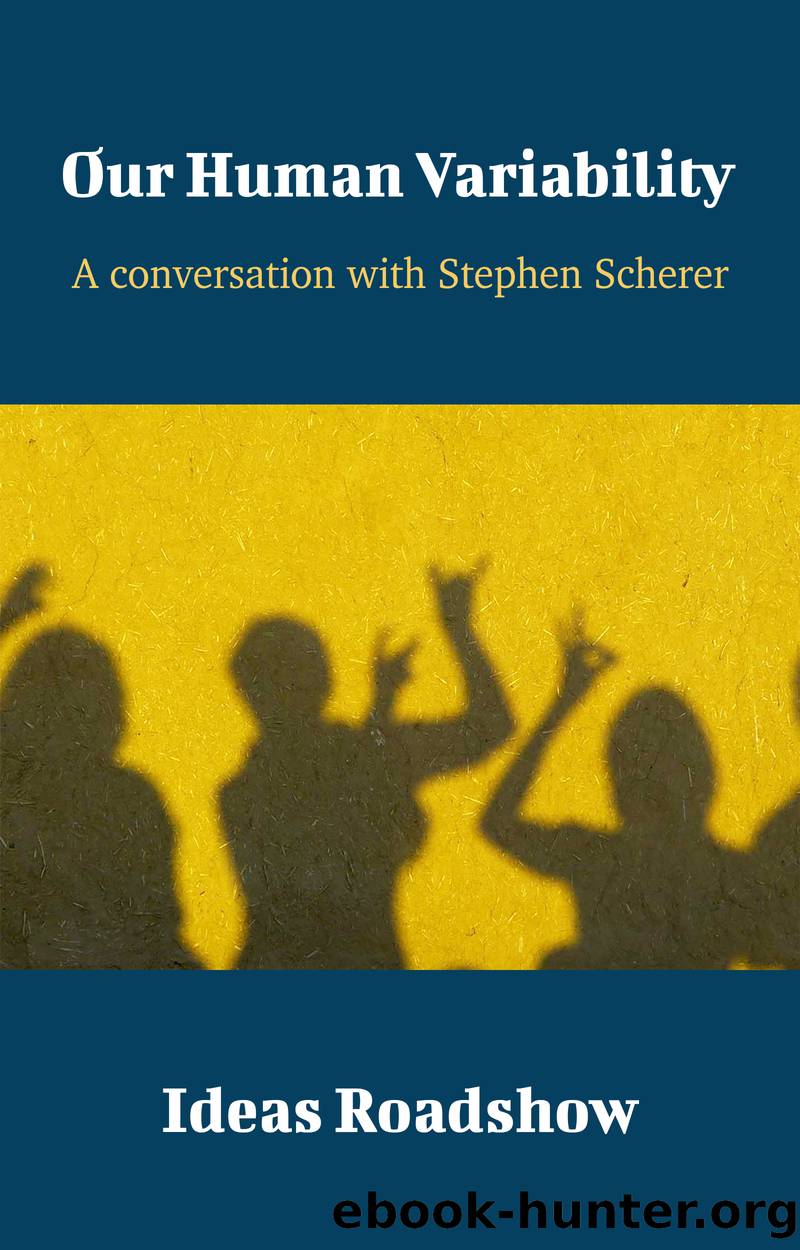Our Human Variability by Burton Howard;

Author:Burton, Howard;
Language: eng
Format: epub
Tags: Biology, Neuroscience, Psychology
Publisher: Open Agenda Publishing
Published: 2020-10-02T00:00:00+00:00
Questions for Discussion:
What do you think Stephen means by, âBiology favours balanceâ?
Why do you think that Stephenâs 2004 paper on CNVs got the least amount of press? Is it the fault of the media? The scientific community? Science popularizers? How common do you think it is that papers scientists consider the most significant have the least public impact?
VIII. Causes and Implications
Complexity galore: autism and other conditions
HB: I want to ask a few questions about biological mechanisms. Whatâs our current understanding of how these large-scale variations are actually happening? And then Iâd like to look at the mechanistic aspects of what that implies.
SS: Weâve got some new data coming out based on our whole genome sequencing experiments, both in autism families and in controls. Just to give you some numbers, if you look at any new human being that is born and compare her DNA sequence to the two parents, the baby would have roughly 100 new genetic changes in her genome. Thatâs a rough number. Some of those are copy number variants. Others are single nucleotide changes.
HB: What would the relative percentages of the two be: copy number variants to single nucleotide changes?
SS: It depends on how you define copy number variation. The way we define it, you would have about half a dozen copy number variants affecting roughly 40 or 50 different genes. The single nucleotide changes that would be new to the individual would be of the order of 60 or so per person. Thatâs from the best data so far. And then there is a lot of mixing and matching, but these are the changes we can detect.
Now we can use that information to see which of those are associated with a specific condition.
HB: OK. And whatâs actually causing those things? Whatâs our best guess as to whatâs going on?
SS: If you think about the chromosomes coming together during meiosis (thatâs when you have the exchange of genetic material between the mom and the dad and the pairing of the chromosomes): every time the cell divides, the chromosomes come together. There are 3 billion pieces of chemical information that have to be replicated in the cell, copied, and then pieced back together. Itâs a very high-fidelity mechanism. Each nucleotide is checked to make sure the right letter is there.
But nature makes mistakes, for whatever reason. If youâre exposed to carcinogens, nature makes more mistakes. When youâre exposed to x-rays, for example, or asbestos, nature makes more mistakes, because the enzymes that do the checking are compromised and donât work as well.
Weâve found that, over time, there are segments of chromosomes that are present that look very similar to each other. You can think of the chromosomes coming together in cell division as being sort of like velcro: if there is a segment up here thatâs very similar in its DNA letter sequence to one that is down there, they can misalign. Then the velcro sort of loops out, and when the enzymes come to replicate the DNA, they skip over these sections and produce a mutation.
Download
This site does not store any files on its server. We only index and link to content provided by other sites. Please contact the content providers to delete copyright contents if any and email us, we'll remove relevant links or contents immediately.
Zika Virus Biology, Transmission, and Pathways by Colin R. Martin(222)
The Psychology of Desire by Wilhelm Hofmann; Loran F. Nordgren(180)
Anatomy Physiology 2e by Kelly a Young Peter Desaix openstax(176)
Jellyfish Age Backwards by Nicklas Brendborg(172)
Selective Anatomy: Prep Manual for Undergraduates (Vol - 1) - 2E by Vishram Singh(157)
Lippincott Illustrated Reviews Flash Cards BIOCHEMISTRY by Denise R. Ferrier && Bradford A. Jameson(156)
In Your Trunk by Mehmet C. Oz M.D(150)
9781638714071-eBook by Unknown(145)
Lifting the Curse of Menstruation by Sharon Golub(143)
Medical Coding Study Guide by Speedy Publishing(140)
Actions for Kids age 1-3 (Engage Early Readers by Dayna Martin(136)
Competency Based Questions and Answers in Physiology: For First MBBS Professional Examination by Sushruthu Academy(130)
Parenting Tips by Sophie Hartigan(124)
Cellular and Molecular Aspects of Myeloproliferative Neoplasms - Part A (Volume 365) (International Review of Cell and Molecular Biology, Volume 365) by Niccolo Bartalucci (editor) Lorenzo Galluzzi (editor)(122)
9798886224238-eBook_v2 by Unknown(117)
Structural plasticity of synapses in Alzheimer's disease by Unknown(115)
Cardiac MRI Certification Exam by Sadeer G. Al-Kindi & Scott E. Janus(114)
Barth syndrome: Cellular compensation of mitochondrial dysfunction and apoptosis inhibition due to changes in cardiolipin remodeling linked to tafazzin (TAZ) gene mutation by unknow(113)
The Psychic Immune System by Kroth Jerry;(111)
